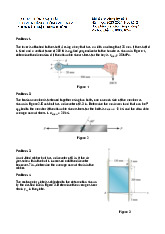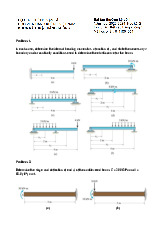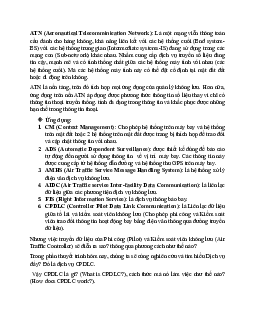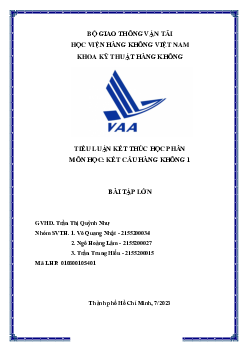







Preview text:
Câu 1: Hardness of material
A Enables a material to resist penetration, wear or cutting.
B The property of a metal which allows it to be reshaped.
C The property of a metal which allows it to be deformed without breaking.
D The property of metal that enables it to withstand force over a period of time. Câu 2:
The applications of Low Alloy Steels is (are) A Landing gears
B Flap ball screwsC Flap tracks D All are correct Câu 3:
The properties of High Alloy Steel is (are)
A Corrosion resistance, anti-chafing, wear resistance B High hardness C High strength D All are correctt Câu 4: In a steel alloy, manganese: A Increases the brittleness.
B Produces a clean, tough and uniform metalC Acts as a hardener. D All are correct Câu 5: The properties of titanium A High strength B High corrosion resistance C Good heat resistance D All are correct Câu 6:
Clading of aluminium alloy means
A Permanently weld aluminium alloy layers onto pure aluminium sheet under highpressure
B Permanently weld pure aluminium layers onto aluminium alloy sheet under highpressure
C Permanently attach aluminium alloy layers onto pure aluminium sheet with rivets
D Permanently weld pure aluminium layers onto aluminium alloy sheet with rivets
Câu 7: Which type of pen CAN NOT be used to make the marks on aluminium material? A Ball point pen B Pencil C Marker pen D All are wrong Câu 8:
Corrosion of matellic metarials
A Occurs due to the tendency of most metals, to return to their natural state
B By combining with the atmospheric oxygenC Both A & B are correct D Both A & B are wrong Câu 9:
Which condition(s) can increase the rate of corrosion A Low temperature B High temperature C Air ventilated area D B & C are correct Câu 10:
How to prevent corrosion of aluminium alloys
A Anodize (a chemical coating) B Aluminium cladding C Top coated with paint D All are correct Câu 11:
The rate of galvanic corrosion depends on
A Sizes of the parts in contact
B Difference of electrical potential C Presence of electrolytes D All are correct Câu 12:
Microbial corrosion usually occurs in A Hydraulic tank B Fuel tank C Cargo compartment D Avionics compartment Câu 13:
Which type of corrosion is this? A Galvanic corrosion B Stress corrosion C Pitting corrosion D Fretting corrosion Câu 14:
Which type of corrosion is this? A Galvanic corrosion B Stress corrosion
C Pitting corrosion (ăn mòn rỗ) D Fretting corrosion Câu 15: (1) is A Root B Crest đỉnh C Pitch D Thread Câu 16: A right hand screw is
A The screw will go in when turn it clockwise
B The screw will go in when turn it counter-clockwise
C The screw can only be turned with right hand D All are wrong Câu 17:
What is the name of this screw recess? A Slotted B Phillips C Torq-set D Hex or Allen Câu 18:
What is the name of this bolt head? A Hex B Countersunk C Double hex D Cap Câu 19:
A bolt has code NAS6405U6, “NAS” means A The family name of the bolt B The name of manufacturer C The standard of the bolt D All are wrong
Câu 20: When install a bolt, how many washers can be used to adjust the grip length? A Maximum 2 washers B Maximum 3 washers C Maximum 4 washers D Unlimited Câu 21:
The high-temperature self-locking nut A
Apply where temperarture exceed 120oC B Can be re-used
C Are made of steel alloyD All are correct Câu 22:
What is the name of this washer? A Spring washer B Tab washer C Lock washer D Shakeproof washer Câu 23: Blind fasteners
A Are designed for dark working environment
B Are designed for blind mechanic
C Are designed for use in passages that are only accessible from one side D All are correct Câu 24:
In Airbus aircraft coordination, the +Y value is A On the left wing B On the right wing
C Upper of cabin floor + 240mm
D Lower of cabin floor + 240mm Câu 25:
The direction of zone numbering is A Left to right B Forward to aft C Inboard to outboard D All are correct Câu 26:
The secondary structure of the aircraft carries
A Flight, ground and pressurization loads
B Air or inertial loads generated on or within its structure C Both A & B are correct D Both A & B are wrong Câu 27: The fail-safe method:
A A duplication of certain structure members to ensure that if one member fail,
theother would assume the load of the failed member.
B Provides the basis for most modern aeroplane designs.
C If a structural member fail, the safe of the flight would be ensure by itself. D B & C are correct Câu 28:
The drain valves on aircraft fuselage
A Are fitted along the lowest points of the pressured fuselage
B Are open when the aircraft cabin is unpressurised
C Are closed when the cabin is pressurised to prevent loss of cabin pressureD All are correct Câu 29:
Which aircraft structure member carries loads? A Frames & Stringers B Skin C Bulkheads D All Câu 30: The top coat of paint coating
A Increase the corrosion resistance properties
B Protect the surface against the corrosive agents
C Gives a good surface for the adhesion of the subsequense paint coatings
D Protect the layers of the primer Câu 31:
Which structural member transport the wing loads? A Frames B Stringers C Skin D Center wing box Câu 32: Scratch (vết trầy) is a
A Line of damage which causes a cross sectional area change
B Damaged area which results in a cross sectional area change producing a
continuoussharp or smooth channel like groove in the material
C Partial fracture or complete break in the material
D Damaged area which is pushed in, with respect to its usual contour. Câu 33: Delamination
A Is when a separation of materials occurs due to an adhesive failure
B Is caused by the pressure and speed of the air at leading edges areas of the wings oraircraft nose
C Is when a separation of plies occurs in a multi-laminate material(xảy ra tách lớp trong vl nhiều lớp)
D Is caused by lightning strike Câu 34:
Which is the possible cause of a burn mark on aircraft skin A Bird strike B Lightning strike C Heavy rain D Hard landing Câu 35:
How to map a damage on aircraft skin?
A Measure the x,y,z coordination of the damage
B Measure the distance to nearest frames & stringers
C Measure the distance to the wings
D Measure the distance to the landing gears Câu 36:
The temporary repair of a structural damage
A The damage is completely repaired
B The damage must be repaired again with permanent repair method C Not necessary to re-inspect D All are wrong
Câu 37: During assessment of a structural damage, the dimension is out of limit in the repair manual
A Use computer program to run the simulation for a new repair solution
B Contact the aircraft manufacturer (Airbus, Boeing, …)
C Just replace the whole damaged part D All are correct
Câu 38: In the diaphragm for allowable limit of a scratch after rework, the vertical axis is
A Percent of (max depth of rework)/(max length of rework)
B Percent of (max depth of rework)/(mix depth of rework)
C Percent of (max depth of rework)/(nominal material thickness) D All are wrong Câu 39: SRM means A Structural Repair Method B Structural Repair Manual C Structural Rework Manual D Structural Rework Method Câu 40:
What is the purpose of this tool
A To measure the depth with high accuracy
B To measure the smoothness of the skin
C To measure the depth with low accuracy D All are correct Câu 41:
A burnt rivet can be replaced with A The same size rivet B The smaller size rivet C The bigger size rivet D The special rivet Câu 42:
Which method is correct for sealant application A (A) is correct B (B) is correct
C (B) is correct but can use (A) in the small area
D (A) is correct but can use (B) in the small area
Câu 43: Which member of passenger door structure hold the door closed when the cabin is pressurize? A Door frames B Door linings
C Door lock hooks or lock pins D Door stop fittings Câu 44:
The cockpit windows, the layers of glass are bonded by A Glue B Sealant C Polyurethane
D A thin layer of pressurized inert gas Câu 45:
Which statement is CORRECT about cabin windows
A Only the outer pane carry differential pressure
B If the outer pane is broken, the inner pane can carry full differential pressureC If
the outer pane is broken, the inner pane can carry differential pressure within 1 hour only
D If the outer pane is broken, aircraft cannot hold the pressure
Câu 46: The inner pane of cabin window has 1 hole in the center bottom A This hole
make sure the pressure between inner & outer panes is the same as the cabin pressure.
B This hole allows condensed water can be drained.
C This hole will make a hustle sound when the outer pane is broken D All are correct Câu 47:
Which structural member carry the main loads on the wing? A The ribs B The spars C The lower skin D All are correct Câu 48: The ribs of wing structure
A Are able to carry torsion, compression & shear loads B Give the shape to the wing
C Provide wall for the fuel tanks D All are correct Câu 49:
In most commercial aircraft, the manholes of the wings are located on
A On the upper skin panel of the wings
B On the lower skin panel of the wings
C On the front spar of the wings
D On the rear spar of the wings Câu 50: The pylon
A Is located under each wing of the aircraft
B Supports the engines which are on each wing, supports and routes systems
betweenthe engine and the wing
C Carry all the loads from the engine to the torque box D All are correct



